MERCEDES-BENZ CLA COUPE 2018 Owner's Manual
Manufacturer: MERCEDES-BENZ, Model Year: 2018, Model line: CLA COUPE, Model: MERCEDES-BENZ CLA COUPE 2018Pages: 326, PDF Size: 5.59 MB
Page 311 of 326
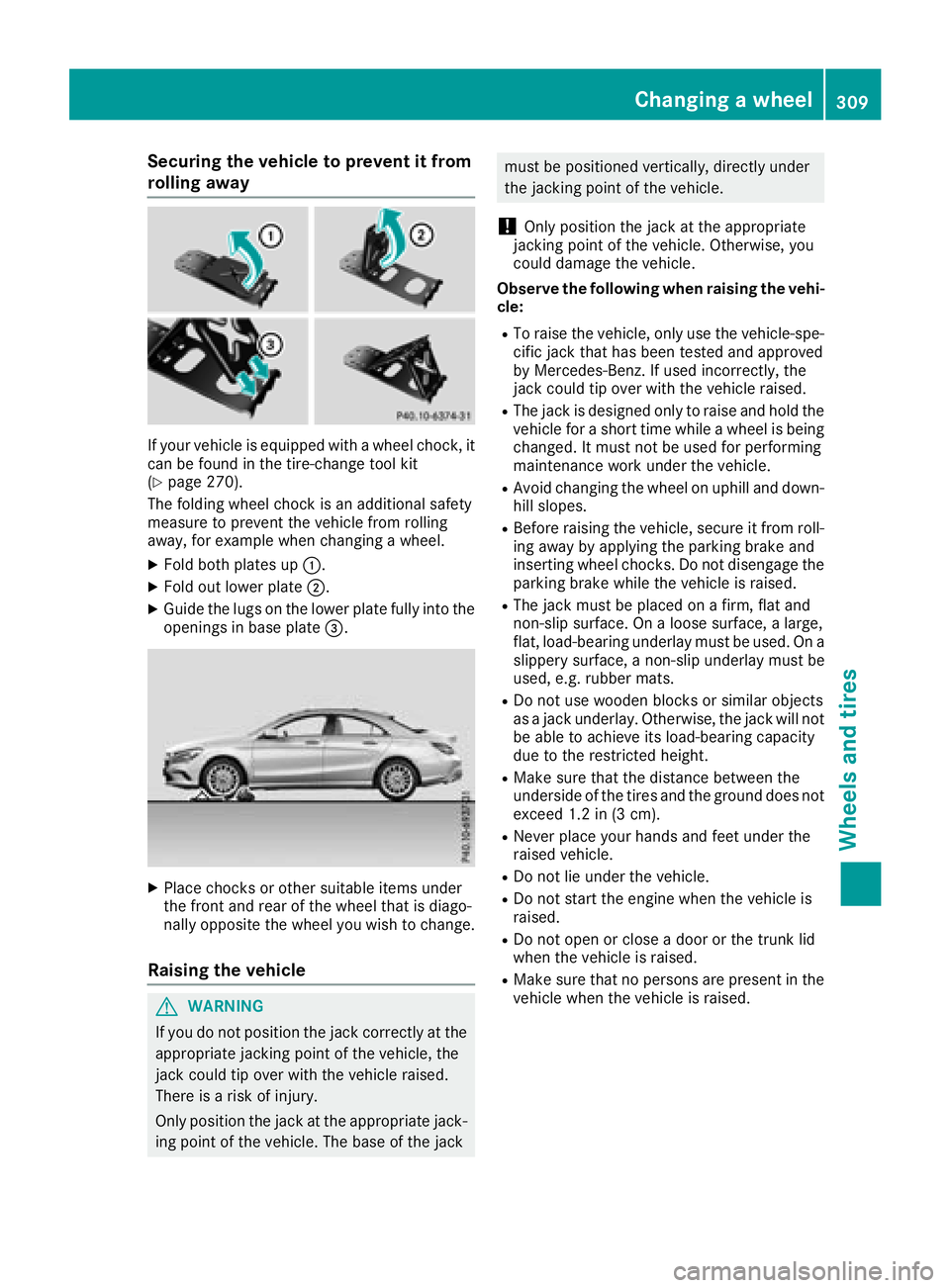
Securing the vehicle to prevent it from
rolling away
If your vehicle is equippedwithaw heel chock,i t
can be found in the tire-change tool kit
(
Ypage 270).
The folding wheel chock is an additional safety
measure to prevent the vehicle from rolling
away,f or example when changing awheel.
XFold both plates up :.
XFold out lower plate ;.
XGuide the lugs on the lower plate fully into the
openings in base plate =.
XPlace chocksorother suitable items under
the front and rear of the wheel that is diago-
nally opposite the wheel you wish to change.
Raising the vehicle
GWARNING
If you do not position the jack correctly at the
appropriate jackingp oint of the vehicle, the
jack could tip over with the vehicle raised.
There is arisk of injury.
Only position the jack at the appropriate jack-
ing point of the vehicle. The base of the jack
must be positioned vertically, directly under
the jackingp oint of the vehicle.
!Only position the jack at the appropriate
jackingp oint of the vehicle. Otherwise, you
could damage the vehicle.
Observe the following when raising the vehi-
cle:
RTo raise the vehicle, only use the vehicle-spe-
cific jack that has been tested and approved
by Mercedes-Benz. If used incorrectly, the
jack could tip over with the vehicle raised.
RThe jack is designed only to raise and hold the
vehicle for ashort time while awheel is being
changed. It must not be used for performing
maintenance work under the vehicle.
RAvoid changing the wheel on uphill and down-
hill slopes.
RBefore raising the vehicle, secure it from roll-
ing away by applying the parking brake and
insertingw heel chocks. Do not disengage the
parking brake while the vehicle is raised.
RThe jack must be placed on afirm, flat and
non-slip surface. On aloose surface, alarge,
flat, load-bearing underlay must be used. On a
slippery surface, anon-slip underlay must be
used, e.g. rubber mats.
RDo not use wooden blocks or similar objects
as ajack underlay. Otherwise, the jack will not
be able to achieve its load-bearing capacity
due to the restricted height.
RMake sure that the distance between the
underside of the tires and the ground does not
exceed 1.2 in (3 cm).
RNever place your hands and feet under the
raised vehicle.
RDo not lie under the vehicle.
RDo not start the engine when the vehicle is
raised.
RDo not open or close adoor or the trunk lid
when the vehicle is raised.
RMake sure that no persons are present in the
vehicle when the vehicle is raised.
Changing awheel309
Wheels and tires
Z
Page 312 of 326
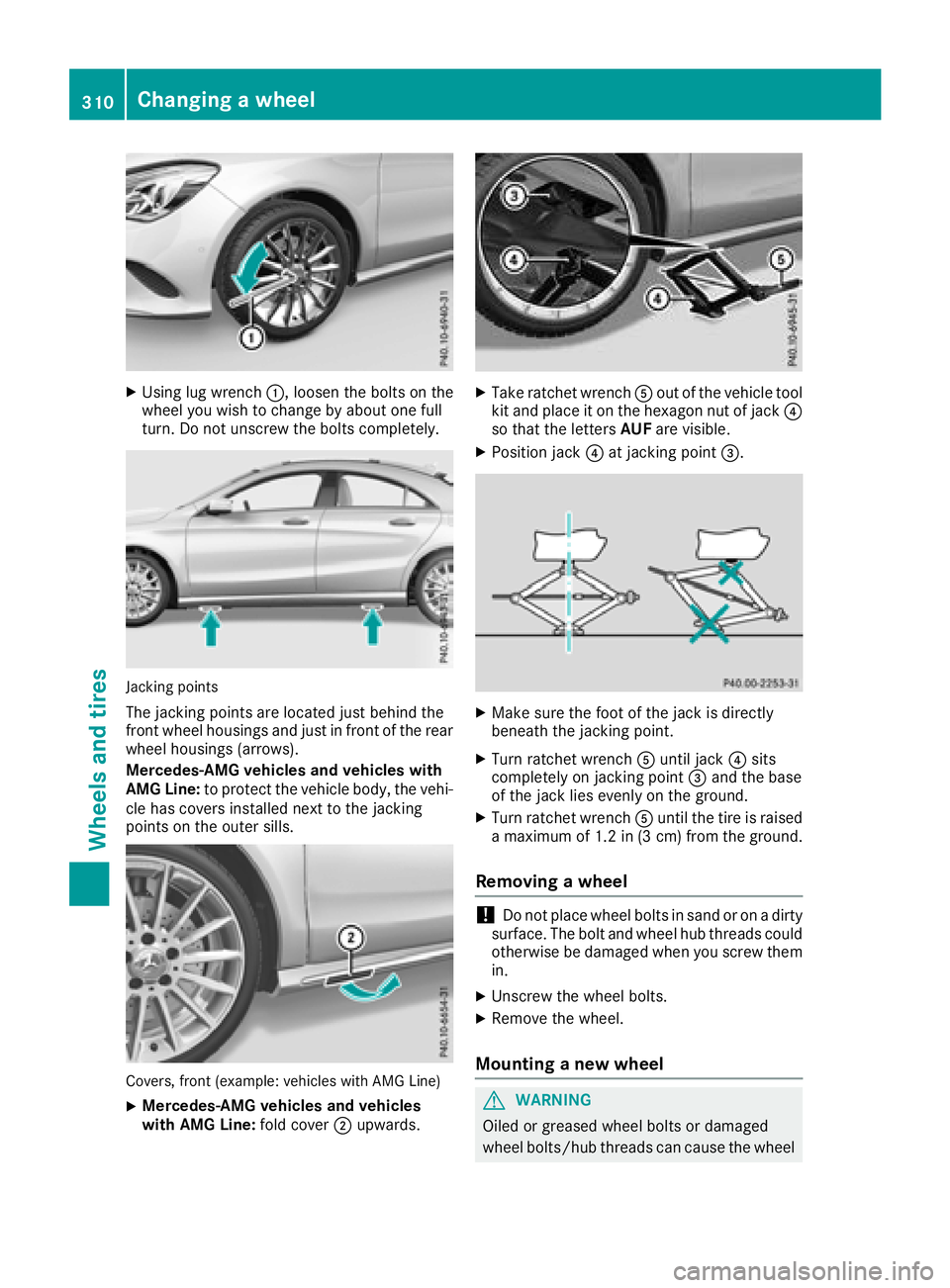
XUsing lug wrench:,loosen the bolts on the
wheel you wish to change by abouto ne full
turn. Do not unscrew the bolts completely.
Jacking points
The jacking points are located just behind the
front wheel housings and just in front of the rear
wheel housings (arrows).
Mercedes-AMG vehicles and vehicles with
AMG Line: to protect the vehicle body, the vehi-
cle has covers installed next to the jacking
points on the outer sills.
Covers, front (example: vehicles with AMG Line)
XMercedes-AMG vehicles and vehicles
with AMG Line: fold cover;upwards.
XTake ratchet wrench Aout of the vehicle tool
kit and place it on the hexagon nut of jack ?
so that the letters AUFare visible.
XPosition jack ?at jacking point =.
XMake sure the foot of the jack is directly
beneath the jacking point.
XTurn ratchet wrench Auntil jack ?sits
completely on jacking point =and the base
of the jack lies evenly on the ground.
XTurn ratchet wrench Auntil the tire is raised
am aximum of 1.2 in (3 cm )from the ground.
Removing awheel
!Do not place wheel bolts in sand or on adirty
surface. The bolt and wheel hub threads could
otherwise be damagedw hen you screw them
in.
XUnscrew the wheel bolts.
XRemove the wheel.
Mounting anew wheel
GWARNING
Oiled or greased wheel bolts or damaged
wheel bolts/hub threads can cause the wheel
310Changing awheel
Wheels and tires
Page 313 of 326
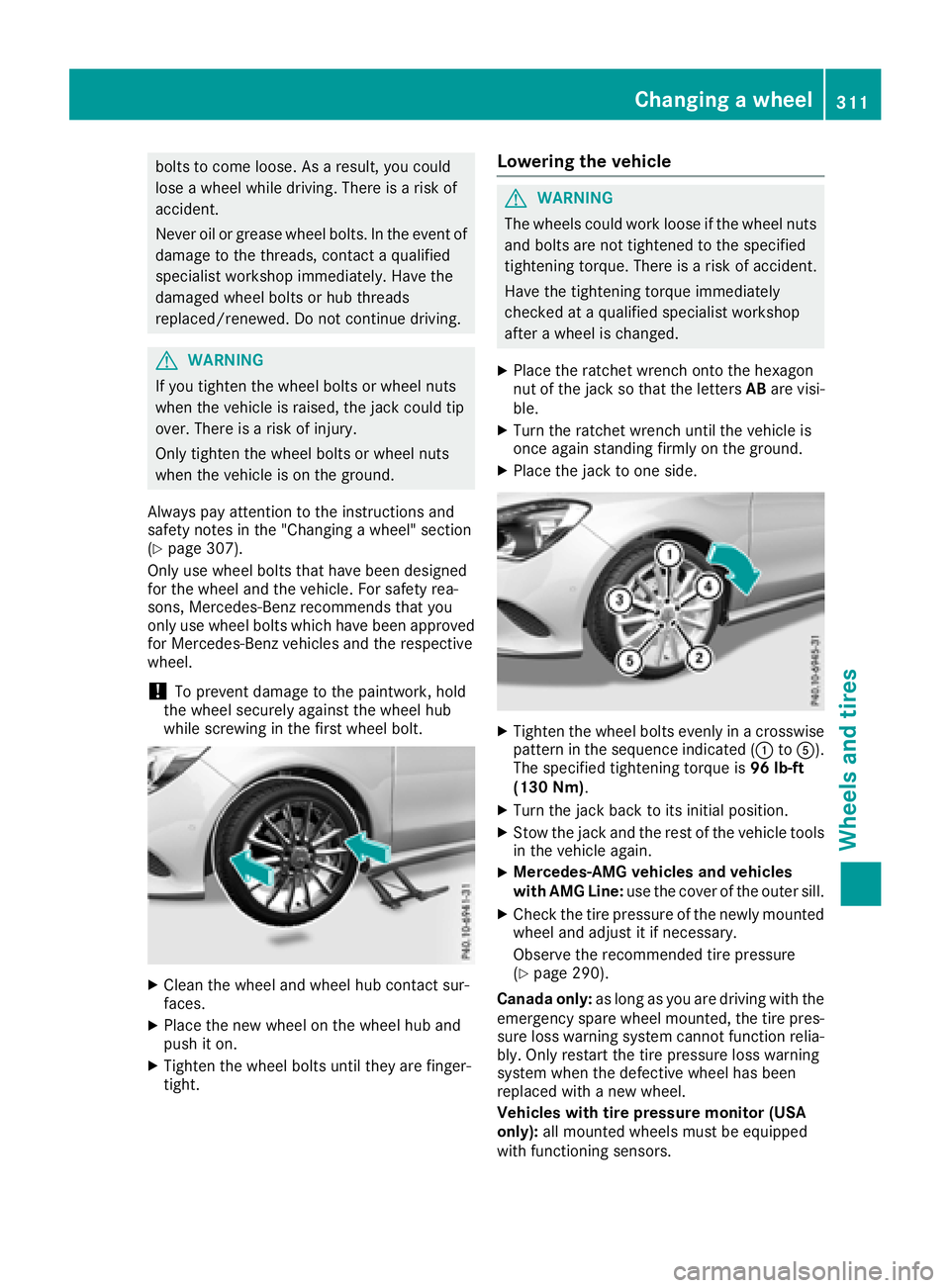
bolts to come loose. Asaresult, you could
lose awheel while driving .There is arisk of
accident.
Never oil or grease wheel bolts. In the event of
damage to the threads, contact aqualified
specialist workshop immediately. Have the
damaged wheel bolts or hub threads
replaced/renewed. Do not continue driving.
GWARNING
If you tighten the wheel bolts or wheel nuts
when the vehicle is raised, the jack could tip
over. There is arisk of injury.
Only tighten the wheel bolts or wheel nuts
when the vehicle is on the ground.
Always pay attention to the instructions and
safety notes in the "Changing awheel" section
(
Ypage 307).
Only use wheel bolts that have been designed
for the wheel and the vehicle. For safety rea-
sons, Mercedes-Benz recommends that you
only use wheel bolts which have been approved for Mercedes-Benz vehicles and the respective
wheel.
!To preventd amage to the paintwork, hold
the wheel securely against the wheel hub
while screwingint he first wheel bolt.
XClean the wheel and wheel hub contact sur-
faces.
XPlace the new wheel on the wheel hub and
push it on.
XTighten the wheel bolts until they are finger-
tight.
Lowering the vehicle
GWARNING
The wheels could work loose if the wheel nuts and bolts are not tightened to the specified
tightenin gtorque. There is arisk of accident.
Have the tightenin gtorque immediately
checked at aqualified specialist workshop
after awheel is changed.
XPlace the ratchet wrenc hontot he hexagon
nut of the jack so that the letters ABare visi-
ble.
XTurn the ratchet wrenc huntil the vehicle is
onc eagain standing firmly on the ground.
XPlace the jack to one side.
XTighten the wheel bolts evenly in acrosswise
pattern in the sequence indicated (: toA).
The specified tightenin gtorque is 96 lb-ft
(130 Nm) .
XTurn the jack back to its initial position.
XStow the jack and the rest of the vehicle tools
in the vehicle again.
XMercedes-AMG vehicles and vehicles
with AMG Line: use the cover of the outer sill.
XCheck the tire pressure of the newly mounted
wheel and adjust it if necessary.
Observe the recommended tire pressure
(
Ypage 290).
Canadao nly:as long as you are driving with the
emergency spare wheel mounted, the tire pres-
sure loss warning system cannot function relia-
bly. Only restart the tire pressure loss warning
system when the defective wheel has been
replaced with anew wheel.
Vehicles with tir epressure monitor (USA
only): all mounted wheels must be equipped
with functioning sensors.
Changing awheel311
Wheels and tires
Z
Page 314 of 326
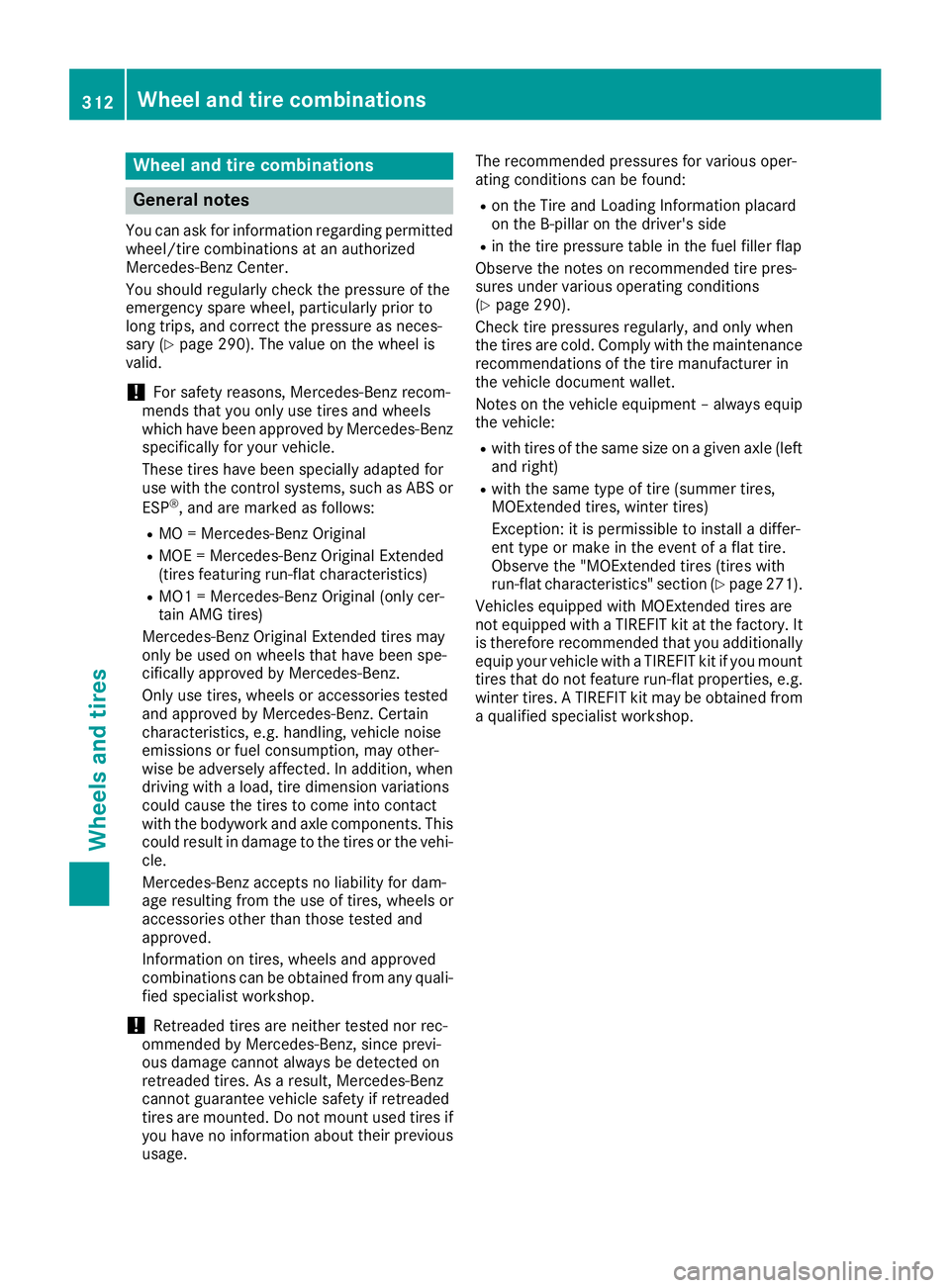
Wheeland tire combinations
General notes
You can ask for information regarding permitted
wheel/tire combinations at an authorized
Mercedes-Benz Center.
You should regularl ycheck the pressure of the
emergency spare wheel, particularly priort o
long trips, and correct the pressure as neces-
sary (
Ypag e290). The valu eonthe wheel is
valid.
!For safety reasons, Mercedes-Benz recom-
mends that you only use tires and wheels
which have been approved by Mercedes-Benz
specifically for you rvehicle.
These tires have been speciall yadapted for
use with the control systems, such as ABS or
ESP
®,a nd are marked as follows:
RMO = Mercedes-Benz Original
RMOE = Mercedes-Benz Original Extended
(tires featuring run-fla tcharacteristics)
RMO1 = Mercedes-Benz Original (only cer-
tain AMG tires)
Mercedes-Benz Original Extended tires may
only be use donwheels that have been spe-
cifically approved by Mercedes-Benz.
Only use tires, wheels or accessories tested
and approved by Mercedes-Benz. Certain
characteristics, e.g. handling, vehiclen oise
emissions or fuel consumption, may other-
wis ebea dversely affected .Inaddition, when
driving with aload, tire dimension variations
coul dcaus ethe tires to come into contact
with the bodywork and axle components. This
coul dresult in damage to the tires or the vehi-
cle.
Mercedes-Benz accepts no liability for dam-
age resulting from the use of tires, wheels or
accessories other than those tested and
approved.
Informatio nontires, wheels and approved
combinations can be obtained from any quali-
fied specialist workshop.
!Retreaded tires are neither tested nor rec-
ommendedbyM ercedes-Benz, since previ-
ous damage cannot alway sbedetected on
retreaded tires. As aresult, Mercedes-Benz
cannot guarantee vehicles afety if retreaded
tires are mounted .Donot mount use dtires if
you have no information abo ut thei
r previous
usage. The recommendedp
ressures for various oper-
ating conditions can be found:
Ron the Tire and Loading Informatio nplacard
on the B-pillar on the driver's side
Rin the tire pressure tabl einthe fuel filler flap
Observe the notes on recommendedt ire pres-
sure sunder various operating conditions
(
Ypag e290).
Check tire pressures regularly,a nd only when
the tires are cold. Comply with the maintenance
recommendations of the tire manufacturer in
the vehicled ocument wallet.
Notes on the vehiclee quipment–alway sequip
the vehicle:
Rwith tires of the same size on agivena xle (left
and right)
Rwith the same type of tire (summer tires,
MOExtended tires, winter tires)
Exception: it is permissible to instal ladiffer-
ent type or make in the event of aflat tire.
Observe the "MOExtended tires (tires with
run-fla tcharacteristics" section (
Ypag e271).
Vehicles equipped with MOExtended tires are
not equipped with aTIREFIT kit at the factory.I t
is therefore recommendedt hat you additionally
equip you rvehiclew ithaTIREFIT kit if you mount
tires that do not feature run-fla tproperties, e.g.
winter tires. ATIREFIT kit may be obtained from
aq ualified specialist workshop.
312Wheela nd tire combinations
Wheels and tires
Page 315 of 326
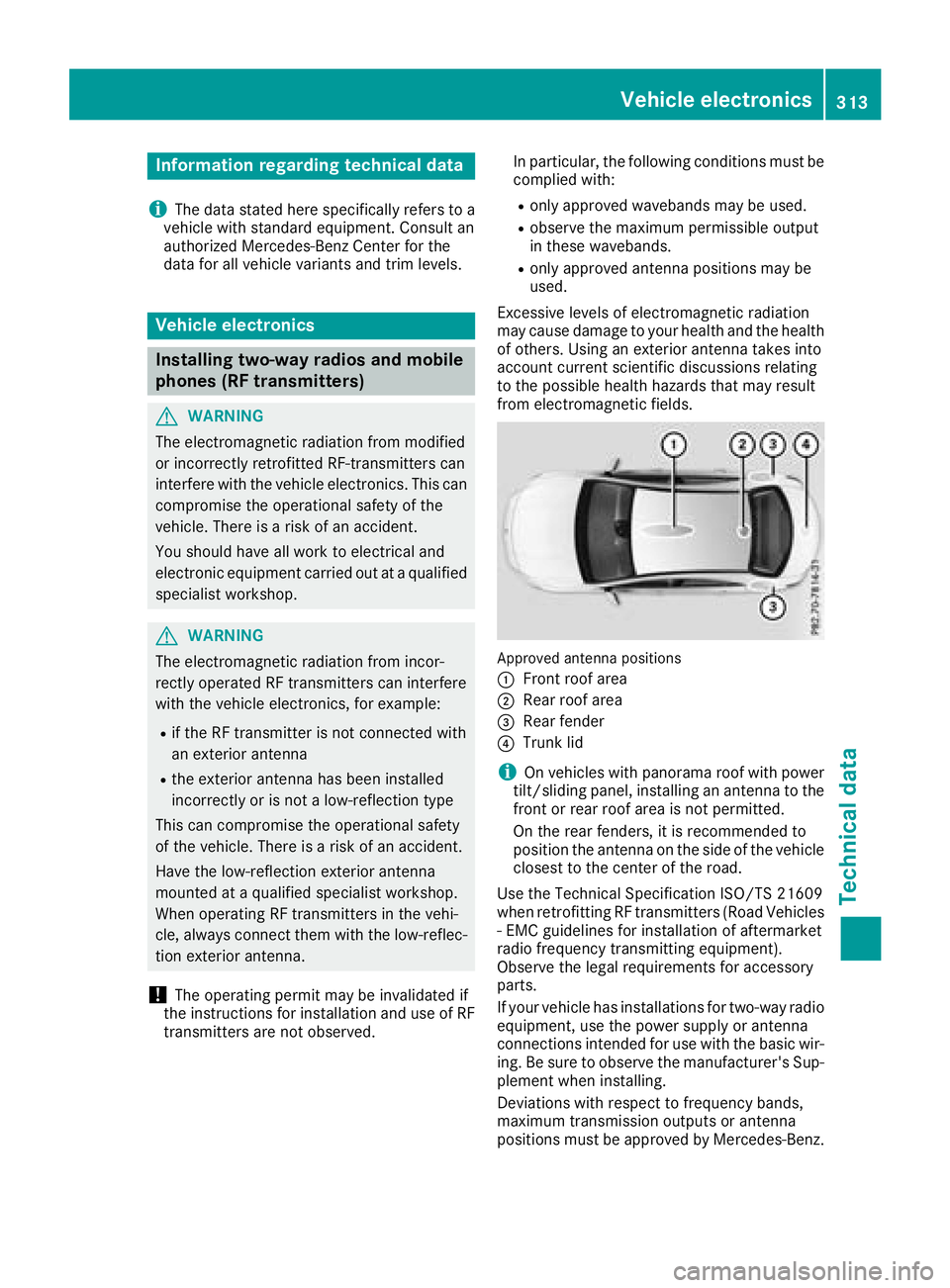
Information regardingtechnicald ata
i
The dat astate dh eres pecifically refers to a
vehicl ewiths tandard equipment. Consult an
authorize dMercedes-Ben zCente rfor th e
dat afor all vehicl evariants and trim levels.
Vehicle electronics
Installing two-way radio sand mobile
phones (RF transmitters)
GWARNIN G
The electromagneti cradiation from modifie d
or incorrectl yretrofitte dRF-transmitters can
interfere wit hthe vehicl eelectronics .This can
compromise th eoperational safet yofthe
vehicle. Ther eisariskofana ccident.
You should hav eall wor ktoe lectrical and
electronic equipmen tcarried out at aqualified
specialist workshop.
GWARNIN G
The electromagneti cradiation from incor-
rectl yoperate dRFtransmitters can interfere
wit hthe vehicl eelectronics ,for example:
Rif th eRFt ransmitte risnotconnecte dwith
an exterio rantenna
Rthee xter iora ntenna has been installed
incorrectl yorisnotalow-reflection typ e
This can compromise th eoperational safet y
of th evehicle. Ther eisariskofana ccident.
Hav ethe low-reflection exterio rantenna
mounte dataqualified specialist workshop.
When operating RF transmitters in th evehi-
cle ,always connec tthe mw itht he low-reflec -
tion exterio rantenna.
!The operating permit may be invalidated if
th ei nstruction sfor installation and use of RF
transmitters are no tobserved. In particular, th
efollowin gconditi onsm ust be
complied with:
Ronly approve dwavebands may be used.
Robserv ethe maximum permissible output
in these wavebands.
Ronly approve dantenna position smay be
used.
Excessiv elevels of electromagneti cradiation
may caus edamag etoyour healt hand th ehealt h
of others. Using an exterio rantenna takes int o
accoun tcurren tscientific discussion srelating
to th epossible healt hhazards that may result
from electromagneti cfields.
Approved antenna position s
:
Fron troo fa rea
;Rear roo farea
=Rear fender
?Trun klid
iOn vehicles wit hpanoram aroofw ithp ower
tilt/slidin gpanel, installin ganantenna to th e
fron torr ear roo farea is no tpermitted.
On th erear fenders, it is recommended to
position th eantenna on th eside of th evehicl e
closes ttothecenter of th eroad .
Use th eTechnical Specification ISO/TS 2160 9
when retrofitting RF transmitters (Road Vehicles
-E MC guidelines for installation of aftermarket
radi ofrequency transmitting equipment) .
Observ ethe legal requirements for accessory
parts.
If your vehicl ehas installation sfor two-way radi o
equipment, use th epower suppl yorantenna
connection sintended for use wit hthe basic wir-
ing .Bes uretoo bservethe manufacturer' sSup-
plemen twhen installing.
Deviation swithr espec ttofrequency bands,
maximum transmission output sorantenna
position smust be approve dbyMercedes-Benz.
Vehicle electronics313
Technical data
Z
Page 316 of 326
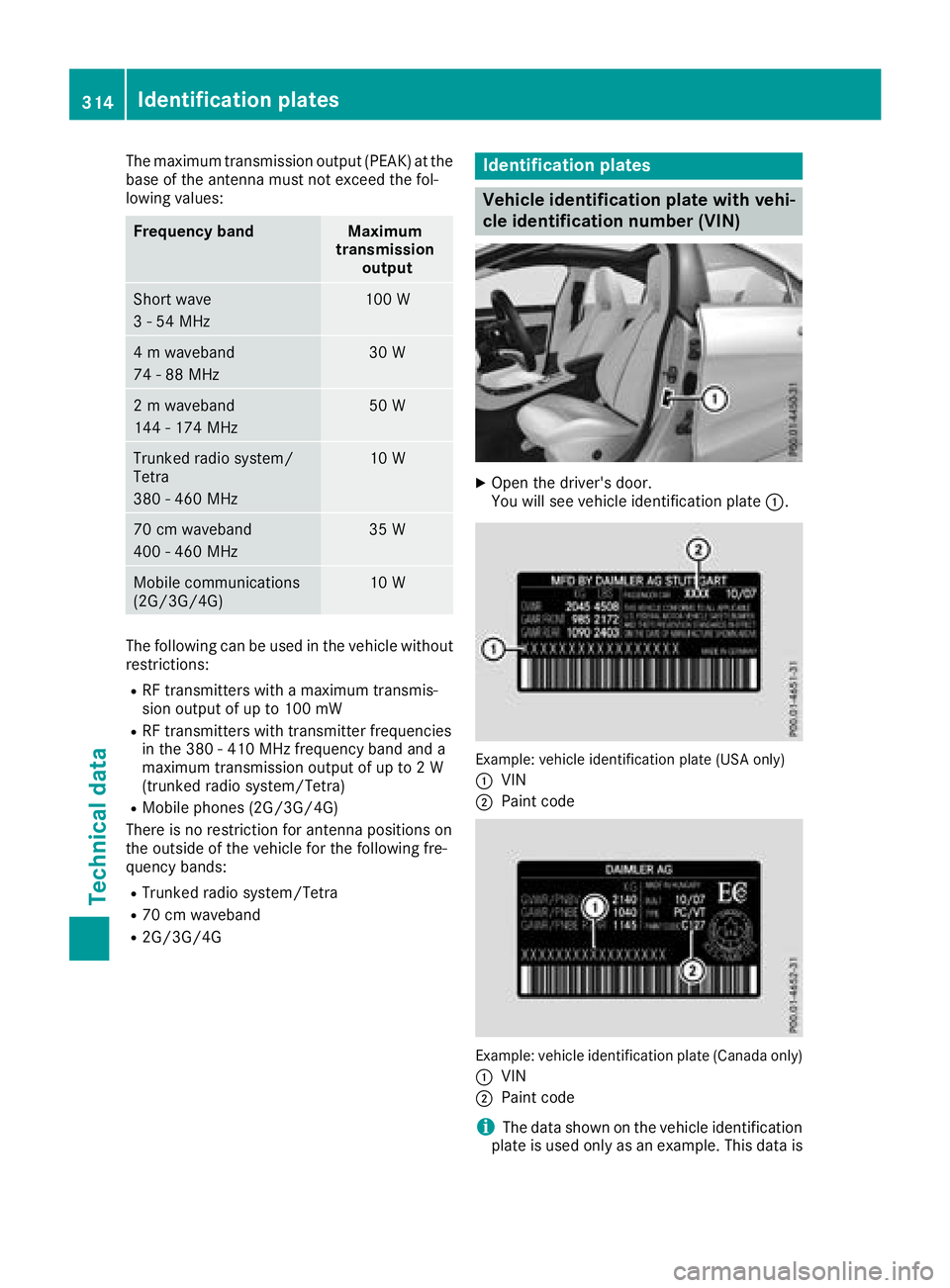
The maximum transmission output (PEAK)atthe
base of the antenna must not exceed the fol-
lowing values:
Frequency bandMaximum
transmission output
Short wave
3-54M Hz100 W
4mwaveband
74 -88M Hz30 W
2mwaveband
144 -174 MHz50 W
Trunked radio system/
Tetra
380 -460 MHz10 W
70 cm waveband
400 -460 MHz35 W
Mobile communications
(2G/3G/4G)10 W
The following can be used in the vehicle without
restrictions:
RRF transmitters with amaximum transmis-
sion output of up to 100 mW
RRF transmitters with transmitter frequencies
in the 380 -410 MHz frequency band and a
maximum transmission output of up to 2W
(trunked radio system/Tetra)
RMobile phones (2G/3G/4G)
There is no restriction for antenna positions on
the outside of the vehicle for the following fre-
quency bands:
RTrunked radio system/Tetra
R70 cm waveband
R2G/3G/4G
Identification plates
Vehicle identification platew ith vehi-
cle identification number (VIN)
XOpen the driver's door.
You will see vehicle identification plate :.
Example: vehicle identification plate (USA only)
:
VIN
;Paint code
Example: vehicle identification plate (Canada only)
:
VIN
;Paint code
iThe data shown on the vehicle identification
plate is used only as an example. This data is
314Identification plates
Technical data
Page 317 of 326

differentfor every vehicle and can deviate
from the data shown here. You can find the
data applicable to your vehicle on the vehicle
identification plate.
Vehicle identification number (VIN)
XSlide the right-han dfronts eat to its rearmost
position.
XFold floor covering :upwards.
You will see VIN ;.
The VIN can also be found on the vehicle iden-
tification plate (
Ypage 314).
The VIN can also be found at the lower edge of
the windshield (
Ypage 315).
Engine number
:Emission control information plate, includ-
ing the certification of both federal and Cali-
fornian emissionss tandards
;VIN (on the lower edge of the windshield)
=Engine number (stamped int othe crank-
case)
Service productsa nd filling capaci-
ties
Important safetyn otes
GWARNING
Service product smay be poisonous and haz-
ardous to health. There is arisk of injury.
Comply with instructions on the use, storage
and disposal of servicep roductsonthe labels
of the respective original containers. Always
stor eservicep roductss ealed in their original
containers. Always keep servicep roductsout
of the reach of children.
HEnvironmental note
Dispose of servicep roductsinanenviron-
mentally responsible manner.
Service product sinclude the following:
RFuels
RLubricants (e.g. engin eoil, transmission oil)
RCoolant
RBrakef luid
RWindshield washer fluid
RClimate control system refrigerant
Components and servicep roductsmust match.
Only use productsr ecommended by Mercedes-
Benz. Damage which is caused by the use of
productsw hich have not been recommended is
not covered by the Mercedes-Benz warrant yor
goodwill gestures .Productsa pproved by
Mercedes-Benz are listed in this Operator's
Manual in the appropriate section.
Information on tested and approved products
can be obtained at aMercedes-Benz Service
Center or on the Internet at
http://bevo.mercedes-benz.co m.
You can recogniz eservice products approvedb y
Mercedes-Ben zbythe followingi nscription on
the containers:
RMB-Freigabe (e.g. MB-Freigabe 229.51)
RMB-Approval (e.g. MB-Approval 229.51)
Other designation sorrecommendations indi-
cat eal evel of quality or aspecification in
accordanc ewith an MB Shee tNumber (e.g. MB
229.5). They have not necessarily been
approvedbyM ercedes-Benz.
Service productsa nd filling capacities315
Technical data
Z
Page 318 of 326
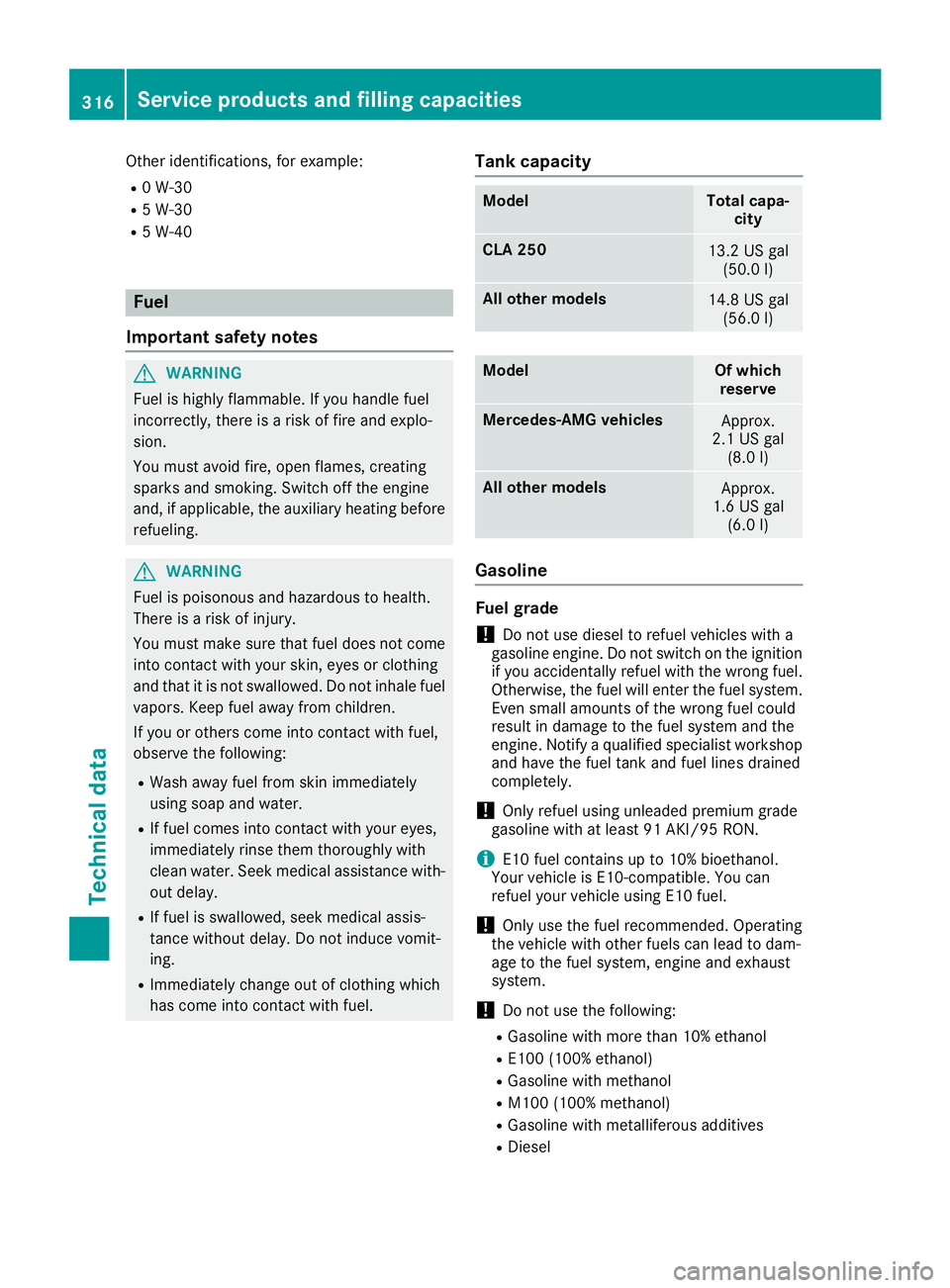
Other identifications, for example:
R0W-30
R5W-30
R5W-40
Fuel
Important safety notes
GWARNING
Fuel is highly flammable. If you handle fuel
incorrectly, there is arisk of fire and explo-
sion.
You must avoid fire, open flames, creating
sparks and smoking. Switch off the engine
and, if applicable, the auxiliary heating before refueling.
GWARNING
Fuel is poisonous and hazardous to health.
There is arisk of injury.
You must make sure that fuel does not come into contact with your skin, eyes or clothing
and that it is not swallowed. Do not inhale fuel
vapors. Keep fuel awayf rom children.
If you or others come into contact with fuel,
observe the following:
RWash awayf uel from skin immediately
using soap and water.
RIf fuel comes into contact with your eyes,
immediately rinse them thoroughly with
clean water. Seek medical assistance with-
out delay.
RIf fuel is swallowed, seek medical assis-
tance without delay.Don ot induce vomit-
ing.
RImmediately change out of clothing which
has come into contact with fuel.
Tank capacity
ModelTotal capa- city
CLA 25013.2 US gal(50.0 l)
Allo ther models14.8 US gal
(56.0 l)
ModelOf which
reserve
Mercedes‑AM GvehiclesApprox.
2.1 US gal (8.0 l)
All other modelsApprox.
1.6 US gal (6.0 l)
Gasoline
Fuel grade
!Do not use diesel to refue lvehicles with a
gasoline engine. Do not switch on the ignition
if you accidentally refue lwith the wrong fuel.
Otherwise, the fuel wil lenter the fuel system.
Even smal lamounts of the wrong fuel could
resul tind amage to the fuel system and the
engine. Notify aqualified specialist workshop
and have the fuel tank and fuel lines drained
completely.
!Only refue lusing unleaded premium grade
gasoline with at least 91 AKI/95 RON.
iE10 fuel contains up to 10% bioethanol.
Yourv ehicleisE 10-compatible. You can
refue lyou rv ehicleu sing E10 fuel.
!Only use the fuel recommended. Operating
the vehiclew ith other fuelscan leadtod am-
age to the fuel system, engine and exhaust
system.
!Do not use the following:
RGasoline with more than 10% ethanol
RE100 (100% ethanol)
RGasoline with methanol
RM100 (100% methanol)
RGasoline with metalliferous additives
RDiesel
316Service products and fillingc apacities
Technical data
Page 319 of 326
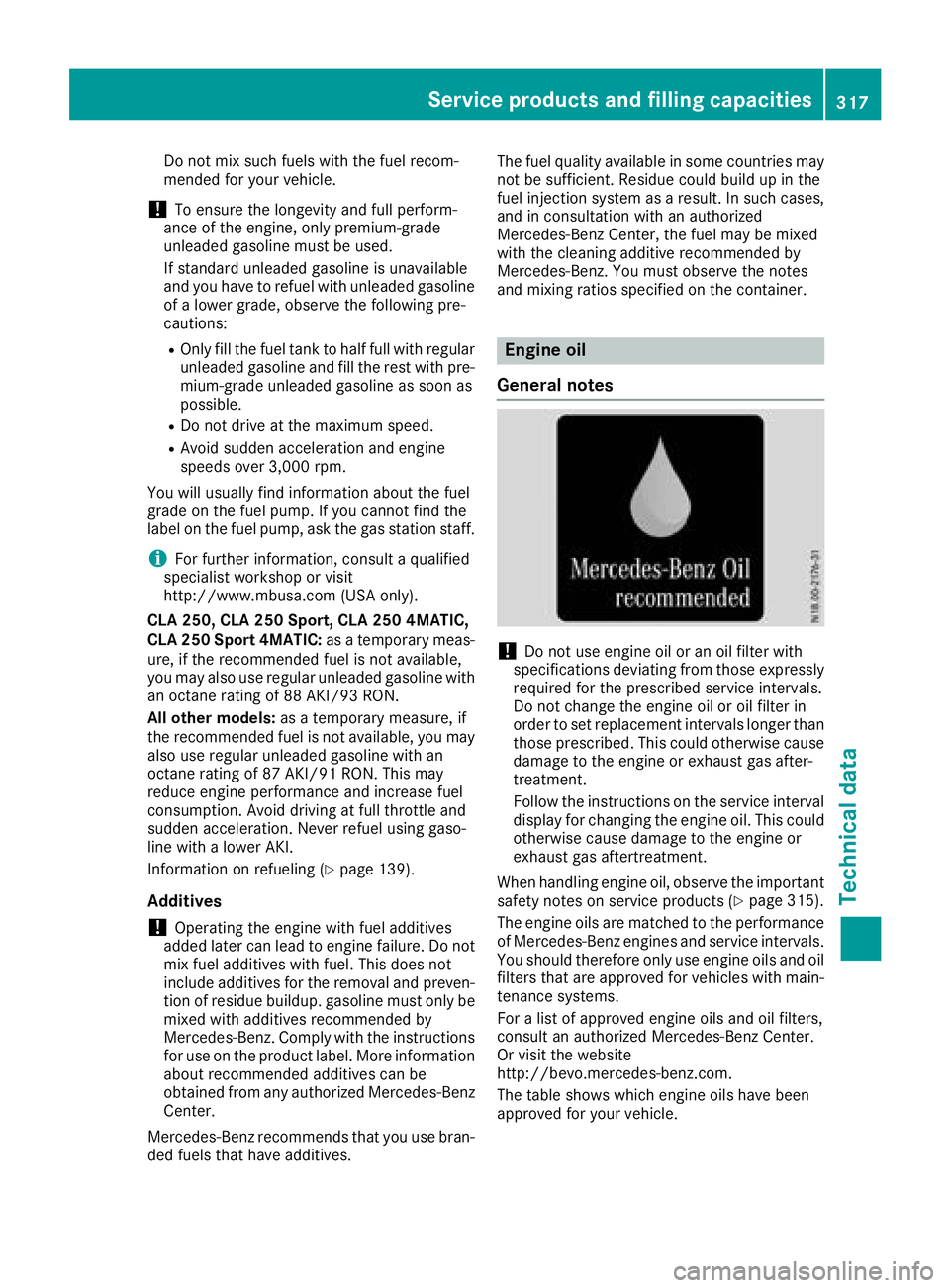
Do not mix such fuelswitht he fuel recom-
mended for your vehicle.
!To ensur ethe longevity and full perform-
ance of the engine ,onlyp remium-grade
unleade dgasoline must be used.
If standard unleade dgasoline is unavailable
and yo uhavetor efuelwithu nleade dgasoline
of alower grade ,observe the following pre-
cautions:
ROnlyf illt he fuel tank to half full with regular
unleade dgasoline and fil lthe res twithp re-
mium-grad eunleade dgasoline as soo nas
possible.
RDo not drive at the maximum speed.
RAvoi dsudde nacceleratio nand engine
speeds ove r3,000 rpm.
Yo uw illu sually find informatio nabout the fuel
grade on the fuel pump. If yo ucanno tfind the
labe lont he fuel pump, as kthe gass tationstaff.
iFor furtheri nformation, consul taqualified
specialis tworkshop or visit
http://www.mbusa.com (USA only).
CL A2 50,CLA 250S port, CL A2504MATIC,
CL A2 50Sport 4MATIC: asatemporary meas-
ure, if the recommende dfuelisn ot available,
yo um ayalso us eregular unleade dgasoline with
an octane rating of 88 AKI /93 RON.
All othe rmodels: asatemporary measure, if
the recommende dfuelisn otava
ilable, yo
umay
also us eregular unleade dgasoline with an
octane rating of 87 AKI/91 RON. Thi smay
reduce engine performance and increase fuel
consumption. Avoi ddrivin gatf ullt hrottle and
sudden acceleration. Never refue lusing gaso-
line with alower AKI.
Informatio nonrefueling (
Ypage 139).
Additives
!Operating the engine with fuel additives
adde dlater can lead to engine failure. Do not
mix fuel additive swithf uel. Thisd oesn ot
includ eaddit ivesfor the remova land preven-
tio nofr esidue buildup. gasoline must onl ybe
mixed with additive srecommende dby
Mercedes-Benz. Compl ywitht he instructions
for us eonthe product label. Mor einformation
abou trecommende daddit ivesc an be
obtained froma ny authorizedMercedes-Benz
Center.
Mercedes-Benz recommends thaty ouuseb ran-
de df uels thath avea ddit ives. The fuel quality availabl
einsomecountries may
not be sufficient. Residu ecould buil dupinthe
fuel injectio nsystem as aresult. In such cases,
and in consultation with an authorized
Mercedes-Benz Center, the fuel maybem ixed
with the cleaning additive recommende dby
Mercedes-Benz. Yo umusto bserve the notes
and mi
xing ratio sspecifie dont he container.
Engine oil
General notes
!Do not us eengine oi lorano ilfilter with
specifications deviating fromt hoseexpressly
required for the prescribe dservic eintervals.
Do not change the engine oi loroilfilter in
order to set replacement intervals longe rthan
thos eprescribed. Thi scould otherwis ecause
damage to the engine or exhaust gasa fter-
treatment.
Follo wthe instructions on the servic einterval
displa yfor changing the engine oil. Thi scould
otherwis ecause damage to the engine or
exhaust gasa ftertreatment.
When handling engine oil, observe the important
safety note sonserviceproducts (
Ypage 315).
The engine oils ar ematchedtot he performance
of Mercedes-Benz engine sand servic eintervals.
Yo us houl dtherefore onl yuseengine oils and oil
filters thata reapproved for vehicles with main-
tenance systems.
For alistofa pproved engine oils and oi lfilters,
consul tanauthorize dMercedes-Benz Center.
Or visit the website
http://bevo.mercedes-benz.co m.
The table shows which engine oils have been
approved for your vehicle.
Service products and filling capacities317
Technical data
Z
Page 320 of 326
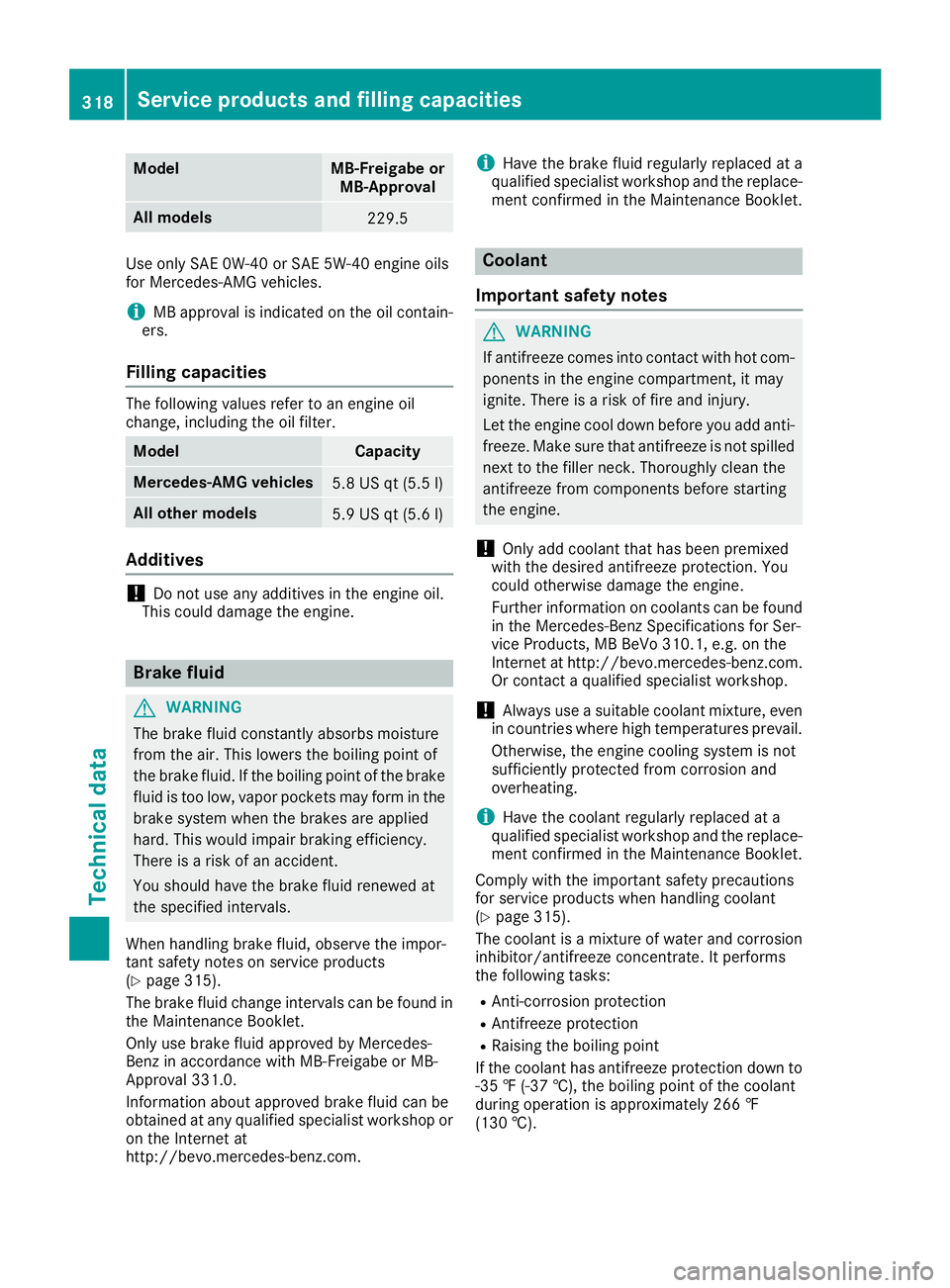
ModelMB-Freigabe orMB-Approval
All models229.5
Use only SAE 0W-40 or SAE 5W-40 engine oils
for Mercedes-AMG vehicles.
iMB approval is indicated on the oil contain-
ers.
Fillingc apacities
The following values refer to an engine oil
change, including the oil filter.
ModelCapacity
Mercedes‑AM Gvehicles5.8 US qt (5.5 l)
All other models5.9 US qt (5.6 l)
Additives
!Do not use any additives in the engine oil.
This could damage the engine.
Brake fluid
GWARNING
The brake flui dconstantly absorbs moisture
from the air. This lowers the boiling point of
the brake fluid. If the boiling point of the brake
flui dist oo low,v aporpockets may form in the
brake system when the brakes are applied
hard. This would impair braking efficiency.
There is arisk of an accident.
You should have the brake flui dreneweda t
the specified intervals.
When handling brake fluid, observe the impor-
tant safety notes on service products
(
Ypag e315).
The brake flui dchange interval scan be found in
the Maintenance Booklet.
Only use brake flui dapproved by Mercedes-
Benz in accordance with MB-Freigabe or MB-
Approval3 31.0.
Information about approved brake flui dcan be
obtained at any qualified specialist workshop or
on the Internet at
http://bevo.mercedes-benz.com.
iHave the brake flui dregularl yreplaced at a
qualified specialist workshop and the replace-
ment confirmed in the Maintenance Booklet.
Coolant
Important safety notes
GWARNING
If antifreeze comes into contact with hot com- ponents in the engine compartment, it may
ignite. There is arisk of fire and injury.
Let the engine cool down before you add anti-
freeze. Make sure that antifreeze is not spilled
next to the filler neck. Thoroughly cleant he
antifreeze from components before starting
the engine.
!Only add coolant that has been premixed
with the desired antifreeze protection. You
coul dotherwise damage the engine.
Further information on coolants can be found
in the Mercedes-Benz Specifications for Ser-
vice Products, MB BeVo 310.1, e.g. on the
Internet at http://bevo.mercedes-benz.com.
Or contact aqualified specialist workshop.
!Always use asuitable coolant mixture, even
in countries where high temperatures prevail.
Otherwise, the engine cooling system is not
sufficiently protected from corrosiona nd
overheating.
iHave the coolant regularl yreplaced at a
qualified specialist workshop and the replace-
ment confirmed in the Maintenance Booklet.
Comply with the important safety precautions
for service products when handling coolant
(
Ypag e315).
The coolant is amixture of water and corrosion
inhibitor/antifreeze concentrate. It performs
the following tasks:
RAnti-corrosion protection
RAntifreeze protection
RRaising the boiling point
If the coolant has antifreeze protection down to -35 ‡(-37 †), the boiling point of the coolant
during operation is approximatel y266 ‡
(130 †).
318Servicep roducts and filling capacities
Technical data